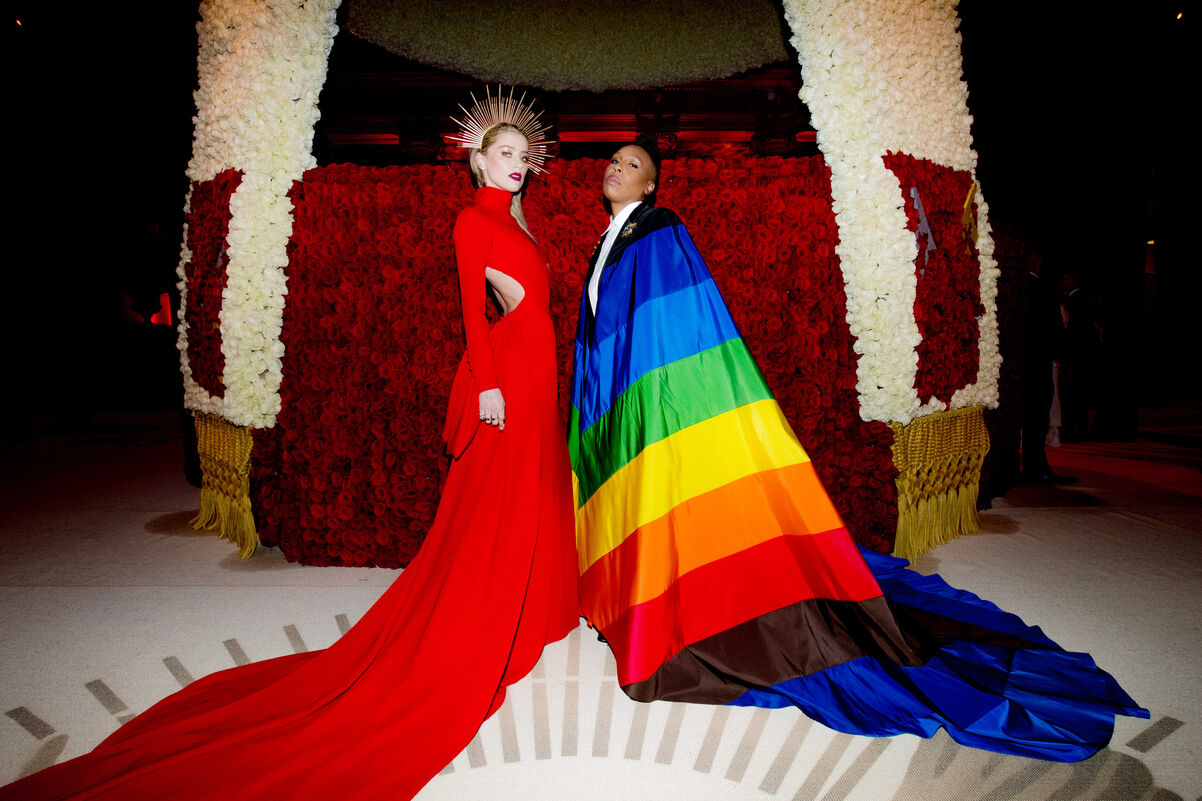Last night, the who’s who of fashion and entertainment went all out for another extravagant Met Gala. With the theme of “Heavenly Bodies: Fashion and the Catholic Imagination” it was a spectacle of religious iconography infused with high fashion.
During a time when most in attendance are at odds with the religious right, it’s a powerful image to behold. Models, actors, singers, and other A-listers took the images that hold such negative power over their communities and made them something beautiful and often queer. It was a protest in and of itself.
With notable queer figures like Janelle Monae, Ruby Rose, and Teen Vogue‘sPhillip Picardi in attendance, the evening’s theme became a chance to reappropriate symbols so often used for oppression. Perhaps making the most waves at the event was Ready Player One actress and The Chi creator, Lena Waithe, who arrived wearing a classic suit under a Pride flag cape, both designed by Carolina Herrera. It was an unequivocal message of queer empowerment in the face of one of its most powerful oppressors, the Catholic church.
“This epic moment of defiance was brought to you by Carolina Herrera,” Waithe wrote in an Instagram caption.
Picardi, who showed up in a gown by up-and-coming queer designer, Charles Jeffrey, posted the look on Instagram with a caption that expressed irony over the event. Having grown up gay in a Catholic household, he found the theme oddly empowering.
“Tonight, that world I escaped and never looked back upon collided with the one in which I found refuge: Fashion,” Picardi posted. “Walking through and examining the holy-inspired pieces by queer designers like Lacroix and Versace and Thom Browne, I saw very clearly that you can’t run away from your upbringing. Instead, you have to find a way to sew those foundational threads into the much larger tapestry of your life.”
The idea of taking a symbol so often used to oppress and making it a symbol of empowerment is nothing new. The upside down pink triangles once used to identify queer prisoners of the Holocaust have long since been a symbol of Pride, reminding us where we came from and what we’ve overcome.
In the case of most religious elements, taking back symbols and experiences are not only an opportunity to take away their oppressive powers. For many, it’s a chance to find the message of love that we were once deprived of by those very religions. Forrising queer musician Parson James, that comes through the gospel genre.
“There is something to be said about authenticity,” James says. “And when I first was going to church, though I never was able to resonate with the sermons so to speak, I could always feel the hurt, power, passion, and fear in the vocals in my Baptist church. Gospel choirs, the instrumentations, grit, soul, the musicality of it all inspired me deeply.”
James has also developed a look for himself that includes a cross earring, inspired by fellow queer musician, George Michael.
For Daniel Lismore, an icon of queer art in London, religious iconography is deeply ingrained in his very aesthetic. Having grown up an altar boy, he no longer identifies with any religion. But he finds inspiration in their many physical expressions.
“When I was a kid, I was always fascinated by religious art,” Lismore says. “And I still am. I go into churches, mosques, temples, and all sorts, everywhere I go in the world. And I love it. I’m not religious. I don’t believe in anything, but I appreciate the beauty of it.”
Lismore is currently preparing an exhibition of his religious-themed work, opening June 2 at the Reykjavik Arts Festival in Iceland. He describes one piece as “Jesus with massive boobs and a dick on a cross.”
“In a way, it’s protest,” he says. “But in a way, it’s not. It’s embracing beauty. Obviously, I’m wary of religious nuts. But I wear it or I use it in my work, and that says enough.”
Although many religions are still used to curtail the progress of queer people, it’s a powerful act to be able to take those symbols held so dearly by religious fanatics and use them to spread a narrative of love and empowerment.
Header imageby Kevin Tachman/Getty Images for Vogue
Don't forget to share:
Help make sure LGBTQ+ stories are being told...
We can't rely on mainstream media to tell our stories. That's why we don't lock our articles behind a paywall. Will you support our mission with a contribution today?
Cancel anytime · Proudly LGBTQ+ owned and operated
Read More in Culture
The Latest on INTO
Subscribe to get a twice-weekly dose of queer news, updates, and insights from the INTO team.
in Your Inbox













